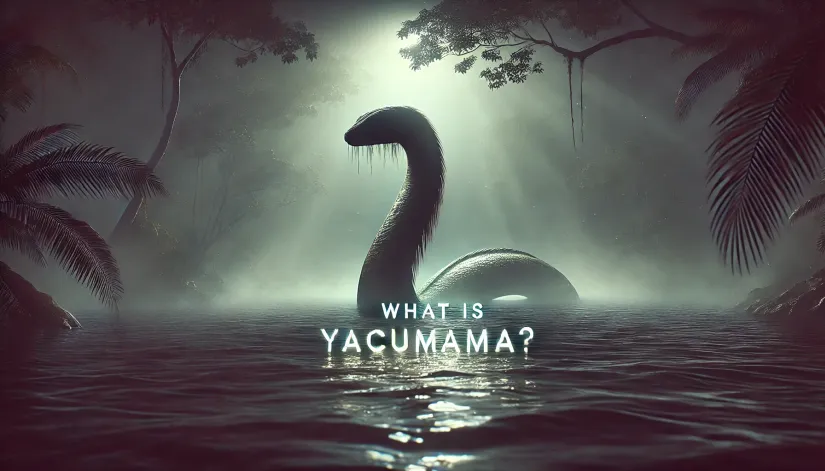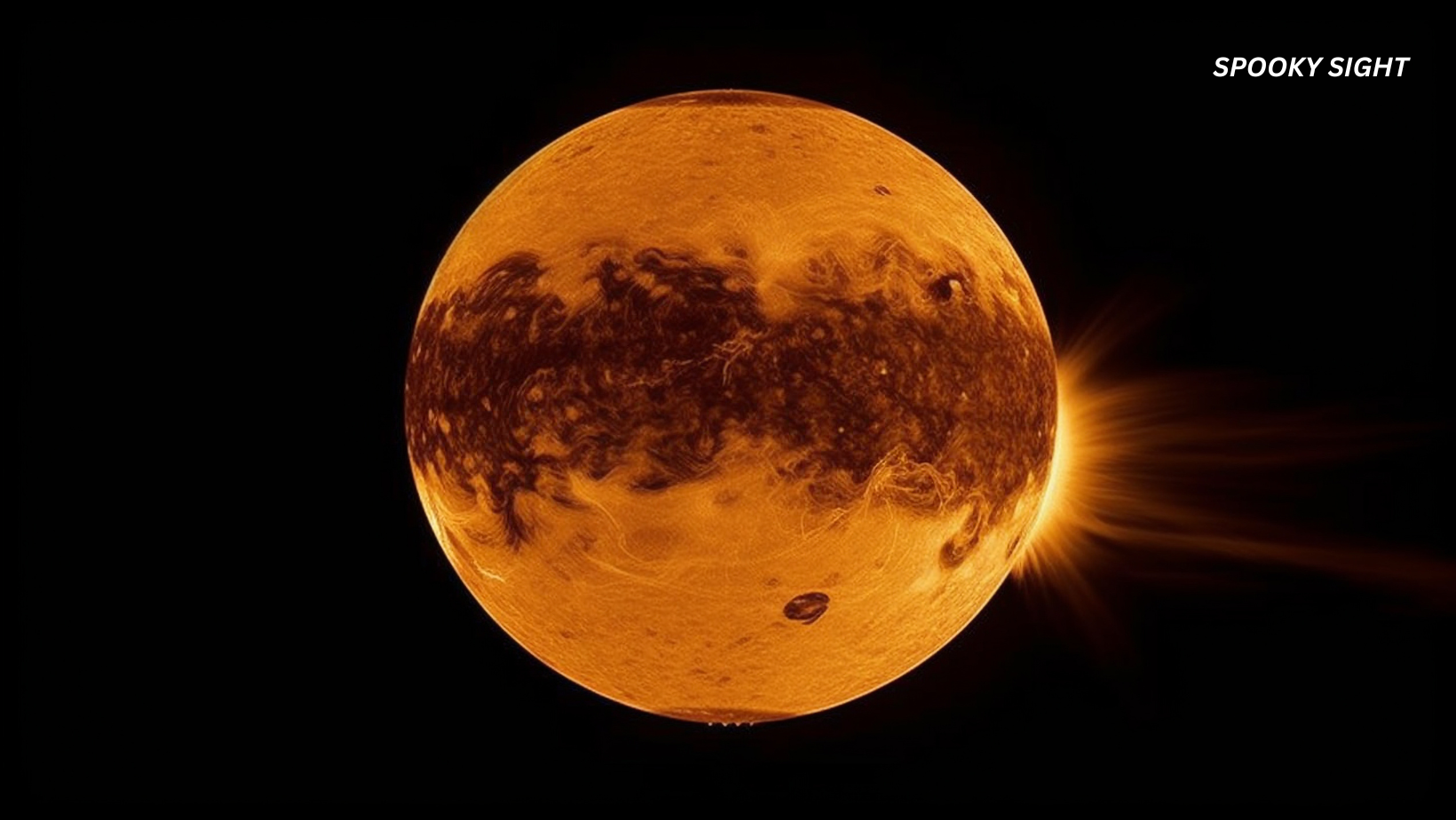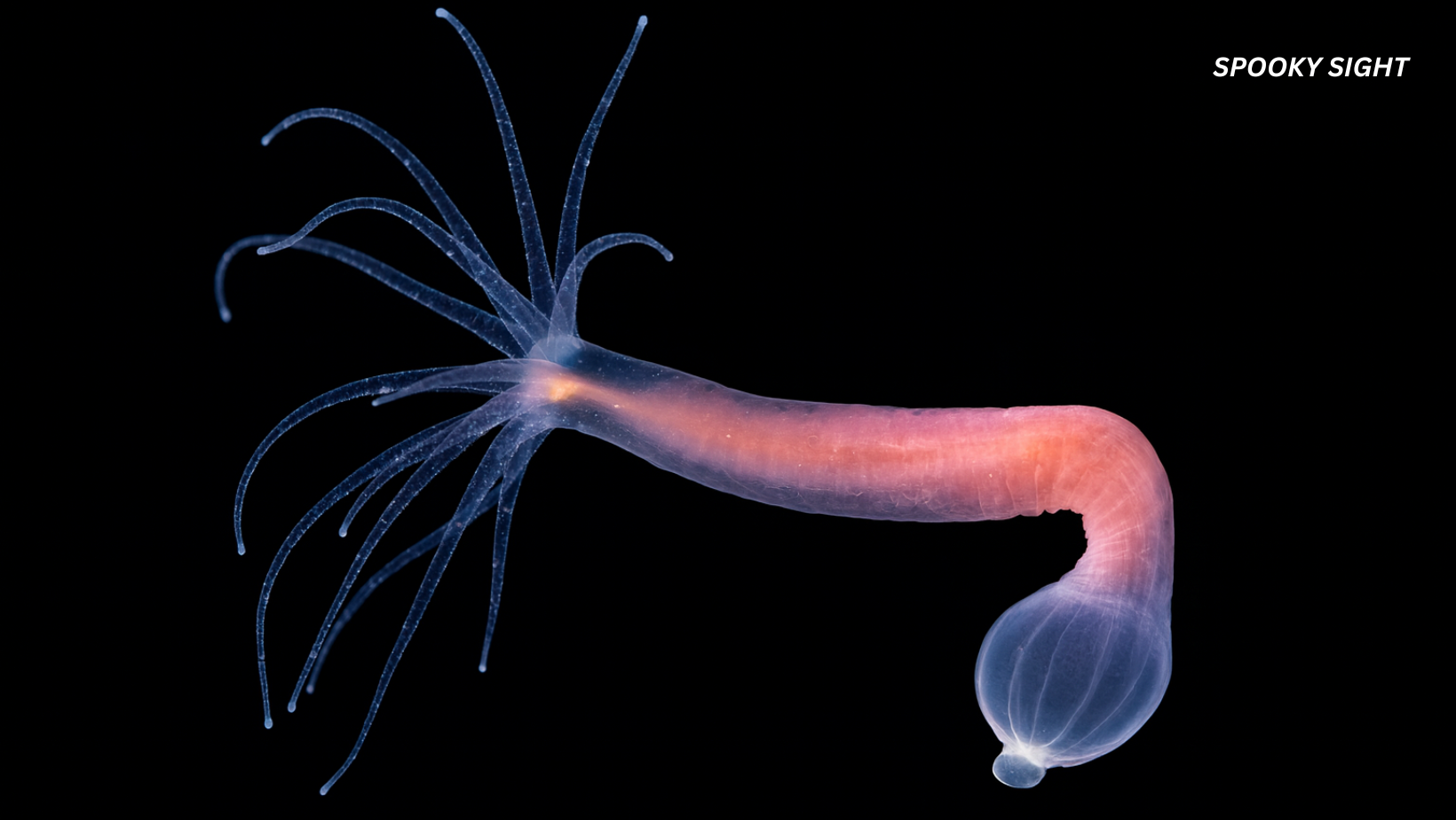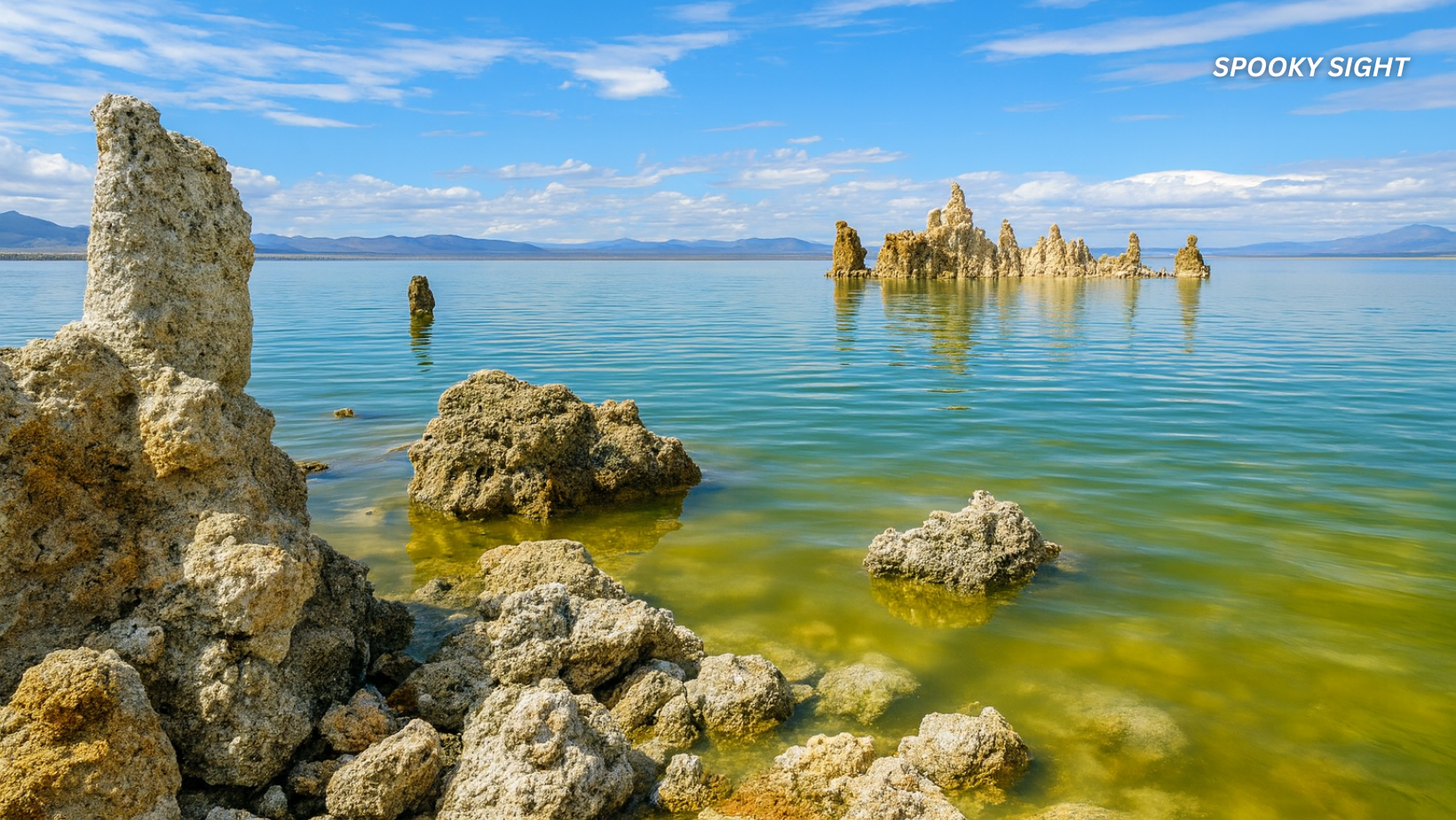Ever heard about the Yacumama? It’s a giant serpent believed to inhabit the depths of the Amazon River Basin. This mysterious creature is both feared and revered by local indigenous peoples and is at the center of countless tales and mysteries.
But does this South American cryptid actually exist, or is it just a myth? Let’s dive into the enigma without spoiling too much from the get-go.
In this article:
What is Yacumama?
Alright, let’s get into the nitty-gritty of the Yacumama. By definition, Yacumama is a giant snake cryptid believed to inhabit the remote waters of the Amazon River Basin, stretching across countries like Peru, Brazil, Ecuador, and parts of Bolivia.
According to the local myths, this creature is so massive that when it moves, it shapes the very landscape of the Amazon, carving out rivers and creating oxbow lakes.
However, in the lore of Indigenous tribes (such as the Shipibo-Conibo and the Quechua people), the giant serpent is more than a legendary beast—it’s the “Mother of Water.” The guardian of rivers and the protector of aquatic life.
In fact, the beast is so influential in local mythology that shamans and elders still pass down countless tales of its power and importance in preserving the balance of the ecosystem.
But the Yacumama isn’t the only serpent lurking in South American folklore. We can easily compare it to other creatures. The Giant Anaconda can be a good example. Yet, while real, it doesn’t reach the mythical sizes attributed to the Yacumama.
Then there’s the Minhocão. A gigantic earthworm or serpent-like creature said to live in the forests and waterways of Brazil.
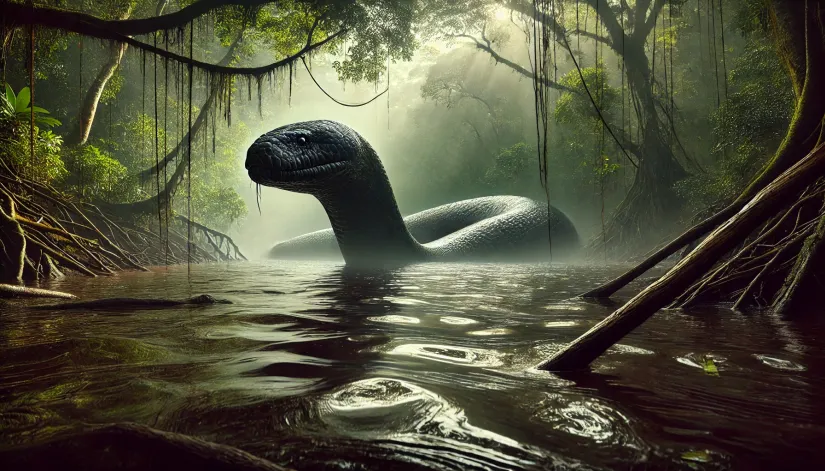
Etymology
In the Quechua language—spoken by indigenous peoples across the Andes and Amazon for centuries—“yaku” means “water,” and “mama” translates to “mother.” So, Yacumama literally means “Water Mother.” This title reflects the creature’s profound connection to the rivers and aquatic life of the Amazon Basin.
The name’s origins date back to pre-Columbian times. Long before Spanish conquistadors arrived in the 16th century. Over centuries, Yacumama has taken over the role of protector of rivers that commands respect and, frankly, a bit of fear.
Comparing this to other cryptid names, using “mama” as a suffix isn’t unique to the Yacumama. Take Pachamama (a goddess in Inca mythology), another Quechua term where “pacha” means “earth.” So, it means “Mother Earth.”
Both names personify natural elements as maternal figures, emphasizing their life-giving and nurturing aspects.
In Brazilian folklore, there’s the Boitatá (a giant fire serpent), whose name is derived from the Tupi language (“mboi” meaning “snake” and “tatá” meaning “fire”). It translates as a “fiery serpent.”
Similarly, the Minhocão combines “minhoca” (earthworm) with the augmentative suffix “-ão,” turning it into a “giant earthworm.”
Can you see the pattern? The cryptid’s (or, in other cases, the mythological creature’s) name reflects its most important characteristic.
An interesting tidbit: the reverence for “mother” figures in naming isn’t limited to South America. Deities and mythical creatures are granted maternal titles in many cultures to signify their power and importance. It’s a linguistic thread that ties together human attempts to understand and personify the forces of nature.
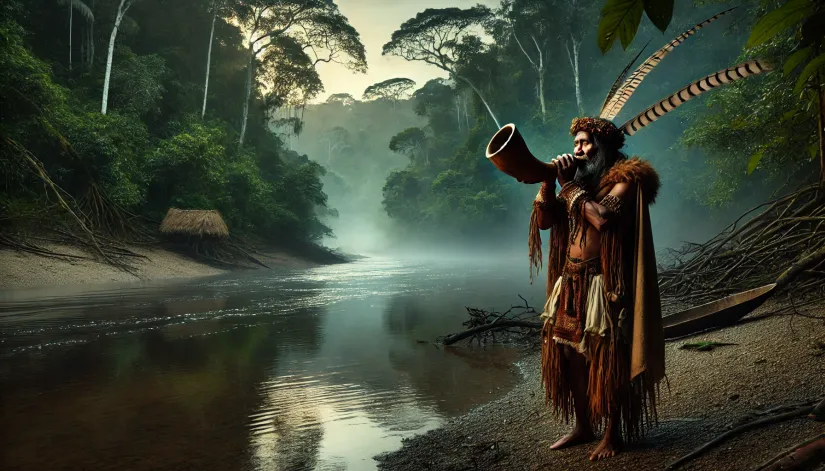
Description and Behavior
Next, let’s see what makes the Yacumama such a legendary figure in Amazonian lore.
First off, Yacumama is big. Like really huge. It can allegedly reach over 100 feet (30 meters) in length. Imagine a creature so immense that it could make the largest known snakes today look like garden snakes in comparison!
To put Yacumama’s size into a more scientific perspective, we can compare it to the green anaconda and the prehistoric Titanoboa.
The green anaconda is the largest snake currently known to science, reaching lengths of up to 30 feet (about 9 meters) and weighing over 500 pounds. Impressive, but still not in the same league as the Yacumama.
Then there’s the Titanoboa cerrejonensis, a prehistoric serpent that lived around 58 to 60 million years ago during the Paleocene period. The Titanoboa fossils discovered in Colombia in 2009 suggest this behemoth could reach up to 42 feet (13 meters) and weigh over 2,500 pounds.
The Titanoboa is the closest real-world counterpart to the Yacumama, lending some plausibility to the idea that such massive snakes once existed—and maybe, just maybe, still do in the unexplored depths of the Amazon.
Physically, the Yacumama is depicted with a serpent-like body, thick and powerful, capable of easily navigating the winding rivers of the Amazon.
Some accounts mention horn-like appendages on its head. These horns might symbolize its ancient and mystical nature, setting it apart from any ordinary snake.
Behavior-wise, this creature is no gentle giant.
Legends say it can create whirlpools by thrashing its colossal body, capable of dragging entire boats underwater.
In fact, local fishermen often speak of people sucked in from as far as 100 paces away, pulled under without a trace. They say that the Yacumama can swallow prey whole—boats and all—leaving no signs of struggle.
The creature’s ability to suck in prey from a distance might be a mythical explanation for the sudden whirlpools and strong currents that are characteristic of the Amazon’s complex waterways. Nevertheless, these fears have forced the locals to come up with all sorts of rituals as a form of protection.
For instance, people would blow on a conch horn before entering rivers or lakes. This way, the Yacumama is alerted to their presence. If the cryptid is nearby, it would supposedly reveal itself, allowing the fishermen to choose a different route or wait until it was safe.
Another intriguing facet of the Yacumama myth involves its connection to the so-called Boiling River (known locally as Shanay-Timpishka), which means “boiled with the heat of the sun.”
Located in Mayantuyacu, Peru, this bizarre river is a geological anomaly with waters reaching temperatures up to 200°F (93°C). The river’s unnaturally hot waters have baffled scientists, as it’s not near any volcanic activity.
However, local shamans and the Asháninka people consider the Boiling River sacred. Legends say the Yacumama travels to this river to rejuvenate and regain strength, attributing its immense power to the geothermal energies of the area.
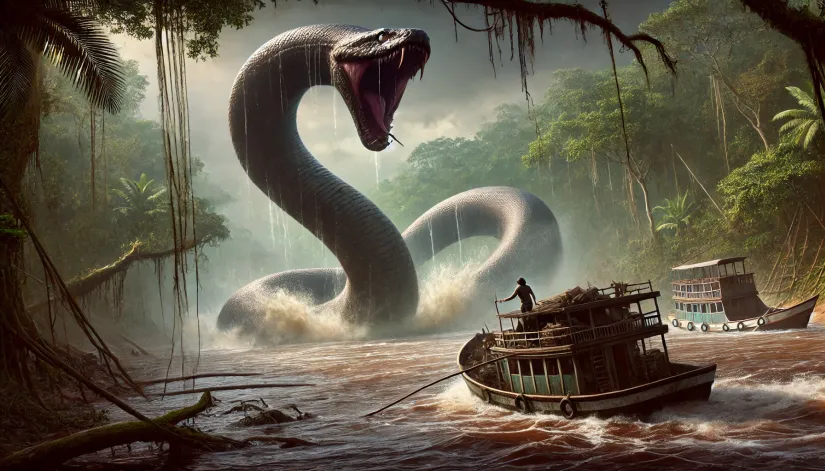
Yacumama Sightings
Over the years, a mix of explorer reports and local testimonies has kept the legend alive in the realm of cryptozoology.
Percy H. Fawcett’s Sighting
One of the most prominent accounts comes from Colonel Percy Harrison Fawcett, a British explorer who ventured deep into the Amazon in the early 20th century.
In 1907, while mapping the border between Brazil and Bolivia for the Royal Geographical Society, Fawcett reported encountering an enormous anaconda near the Rio Abuna. He claimed the snake measured a staggering 62 feet (about 19 meters) in length.
Fawcett described how his team shot the creature. However, despite its size, it managed to slip away into the river’s depths.
His detailed logbooks provided one of the earliest and most sensational pieces of evidence suggesting that giant serpents might inhabit the Amazon. Plus, beyond the 1907 sighting, Fawcett’s journals detail other instances where he and his team felt the presence of something enormous lurking beneath their canoes.
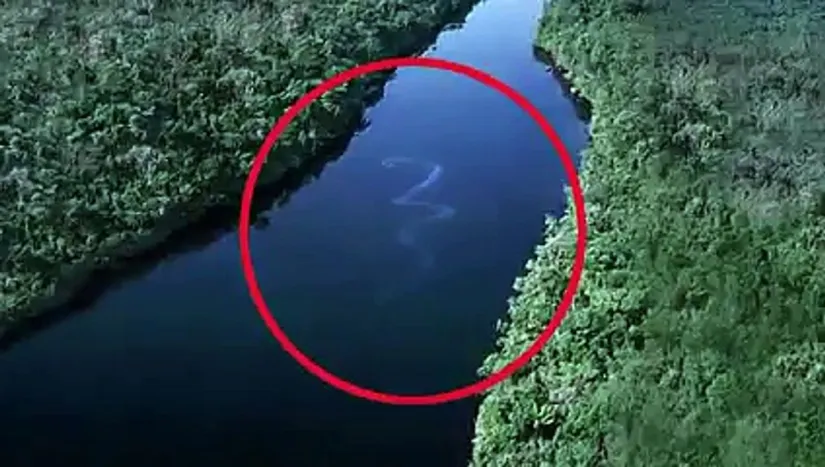
Mike Warner’s Satellite Image
In 2009, a man named Mike Warner allegedly spotted a massive serpent-like shape while examining satellite images of the Amazon River. The form, which appeared to be moving through the water, sparked widespread speculation. Some cryptozoologists called it the “Amazon Nessie.”
While the satellite image was indeed interesting, skeptics argued it could easily be a boat wake, a floating log, or a digital artifact rather than proof of a giant snake.
Another story related to the Yacumama legend is the so-called “bomb incident” from the early 1900s.
Workers constructing a bridge over a remote part of the Amazon River reportedly encountered a massive serpent obstructing their progress. Unable to move the creature, they supposedly used dynamite to wound it.
Despite the explosion, the serpent survived and disappeared into the river. However, the account lacks any official documentation.
Juan Carlos Palomino’s Claim
In the early 2000s, Peruvian fisherman Juan Carlos Palomino reportedly killed an anaconda measuring over 40 feet (approximately 12 meters) near the Ucayali River in eastern Peru.
Photos circulated showing Palomino with the massive snake, fueling debates about the existence of giant serpents. While some hailed it as proof, experts noted that anacondas rarely exceed 30 feet (about 9 meters), and the photographic evidence was inconclusive.
Other Notable Sightings
Along the Brazil-Paraguay border, there are many stories of fishermen disappearing without a trace. Many think that Yacumama may be responsible for these vanishings.
There are also reports of boats capsized by unseen forces, and enormous ripples in the water have been cited as evidence of the creature’s presence.
It is worth noting that these accounts are anecdotal and lack empirical proof.
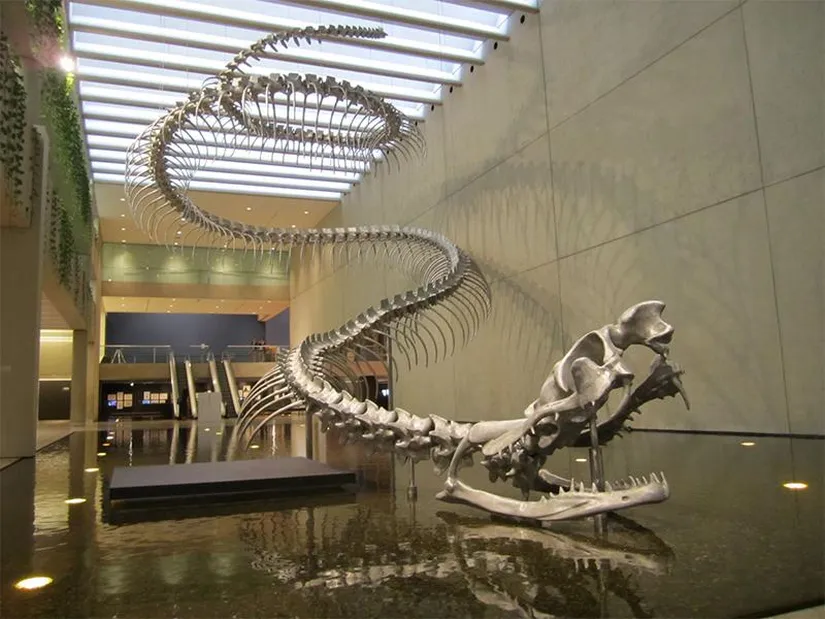
Scientific Theories and Skepticism
Regarding this South American cryptid, science offers some intriguing possibilities—and a fair share of skepticism.
One theory suggests that the legend might be a distant echo of prehistoric creatures like the Titanoboa we mentioned before.
Discovered in 2009 in the Cerrejón coal mines of Colombia, Titanoboa fossils suggest that this prehistoric monster could reach up to 42 feet (13 meters) in length and weigh over 2,500 pounds (1,135 kilograms).
While not quite the 100-foot behemoth of legend, the Titanoboa was unquestionably a massive serpent that once slithered through ancient rainforests.
Perhaps the ancestors of today’s Amazonian tribes somehow stumbled upon a similar Titanoboa fossil?
Natural phenomena might also have inspired the myth. The Amazon River is notorious for its powerful currents, sudden whirlpools, and unexpected tidal bores. All of which can easily overturn small boats or pull swimmers under without warning.
It’s not a stretch to think that these dangerous water conditions were attributed to a giant serpent lurking beneath the surface. The idea of a creature capable of creating whirlpools (or sucking in prey from a distance) could be a way to explain the river’s perilous nature.
Misidentification could also be a likely culprit. Giant anacondas, caimans, or floating logs could easily be mistaken for gigantic reptiles. Even more so in the murky, low-visibility waters of the Amazon.
Add a little bit of exaggeration, and you will have the perfect mix for an enduring legend. A 20-foot snake becomes a 40-foot monster. And before you know it, you’re dealing with a 100-foot legendary beast.
Is Yacumama Real?
So, what’s the final verdict on the Yacumama? Here’s our take:
While there’s a heap of stories, sightings, and cultural significance attached to this legendary serpent, the hard scientific evidence is, well, missing in action.
Interestingly, the Yacumama hasn’t garnered as much attention in cryptozoology circles. There haven’t been significant expeditions or dedicated research efforts to prove its existence. At least not when compared to other famous cryptids.
Contrast this with the Loch Ness Monster in Scotland or the Mokele-mbembe in Africa’s Congo River Basin—both subjects of numerous searches and extensive studies, yet still lacking concrete evidence.
Other cryptids like Canada’s Ogopogo, the Flathead Lake Monster in Montana, Australia’s Bunyip, and Argentina’s Nahuelito also echo the themes of massive, mysterious water-dwellers. Lots of tales, lots of intrigue—but, again, not much proof.
But here’s the thing: The Amazon Rainforest is one of the planet’s most remote and unexplored regions. Vast stretches of dense jungle and intricate river systems remain uncharted, and new species of animals and plants are discovered all the time.
Could unknown creatures be hiding in its depths? It’s something we can’t 100% exclude.
But, if there’s a yet-undiscovered snake species in the Amazon, it’s unlikely to be as colossal as the legends suggest. Science tells us that animals of such enormous size would require specific environmental conditions and abundant resources to survive—factors that make a 100-foot serpent… improbable.

